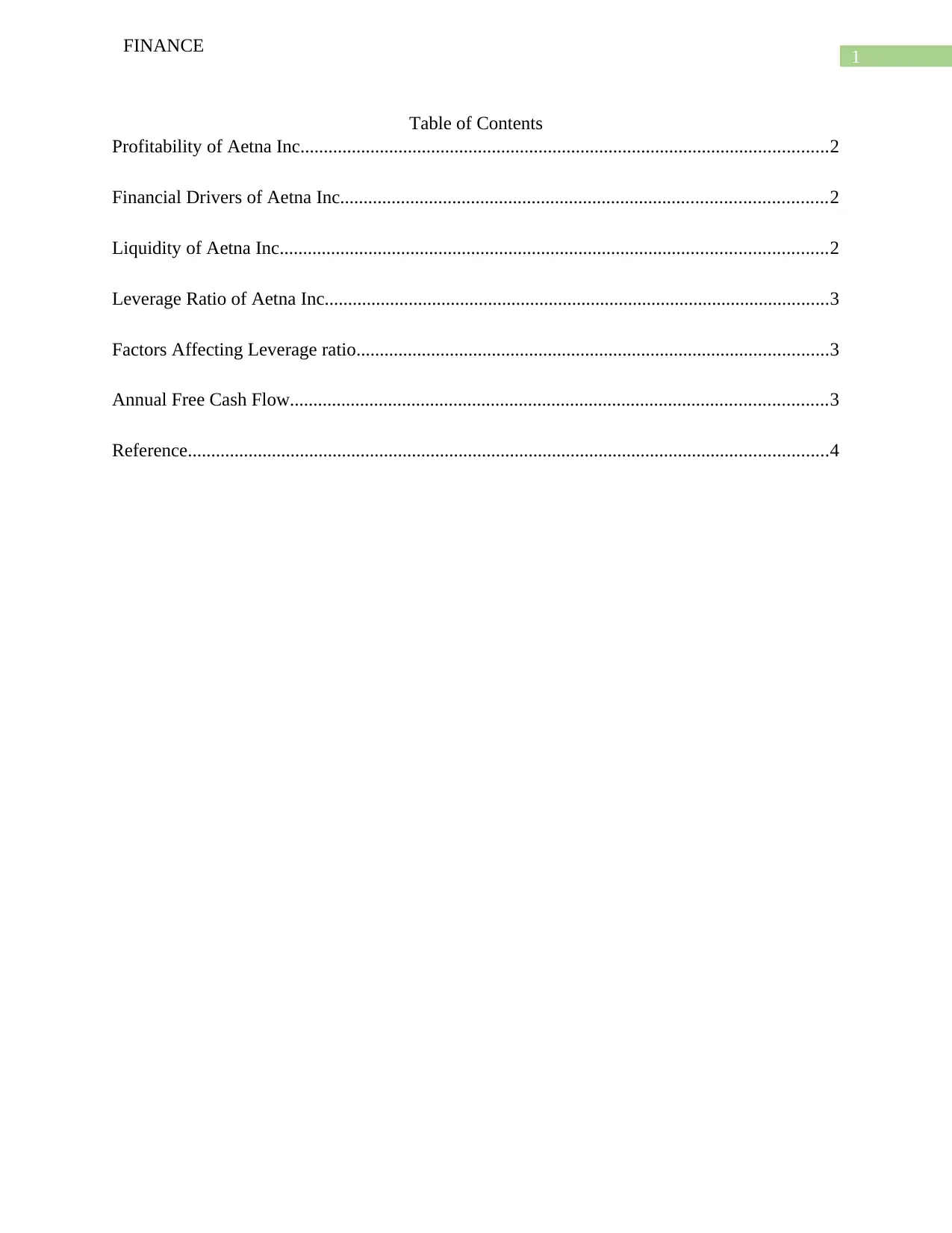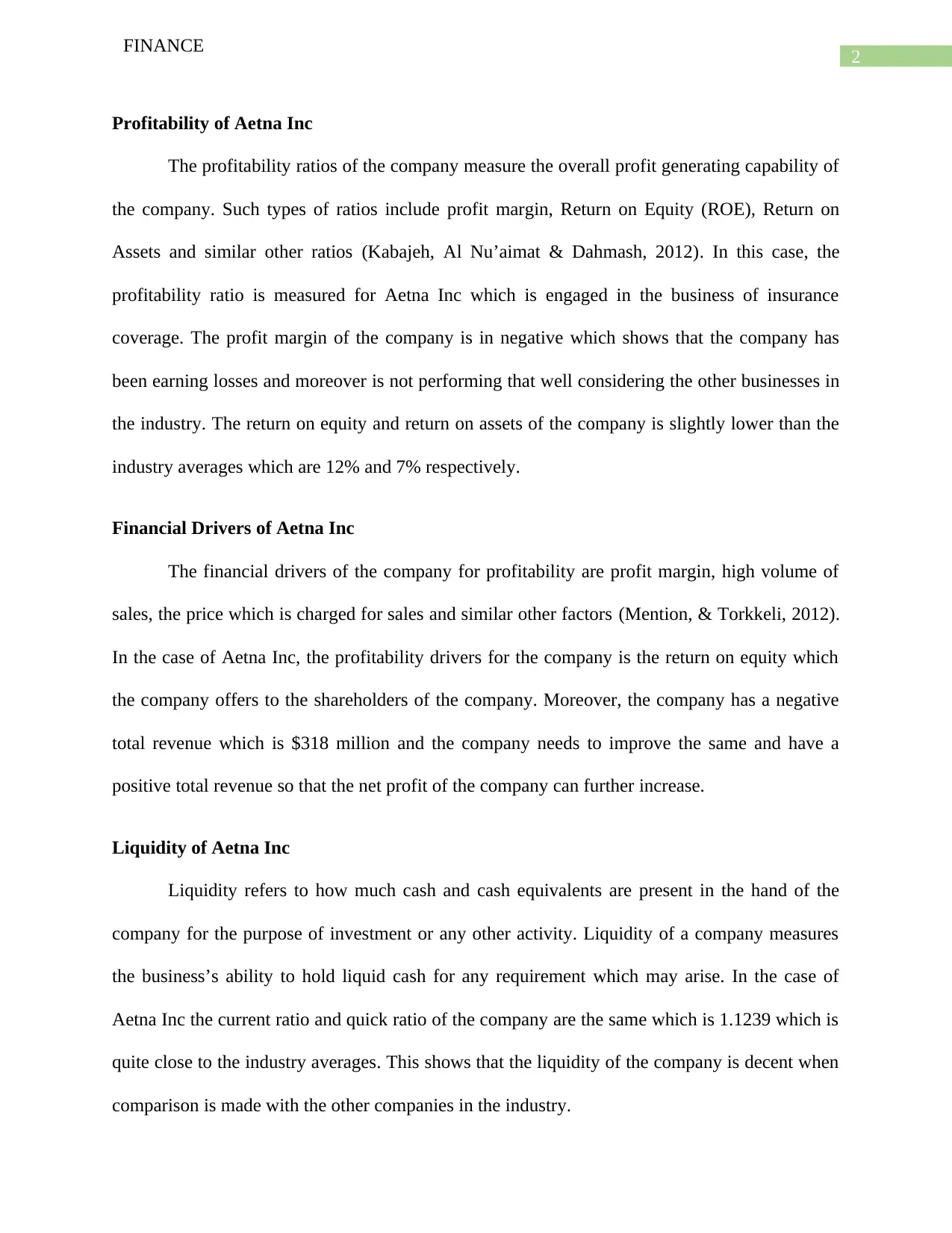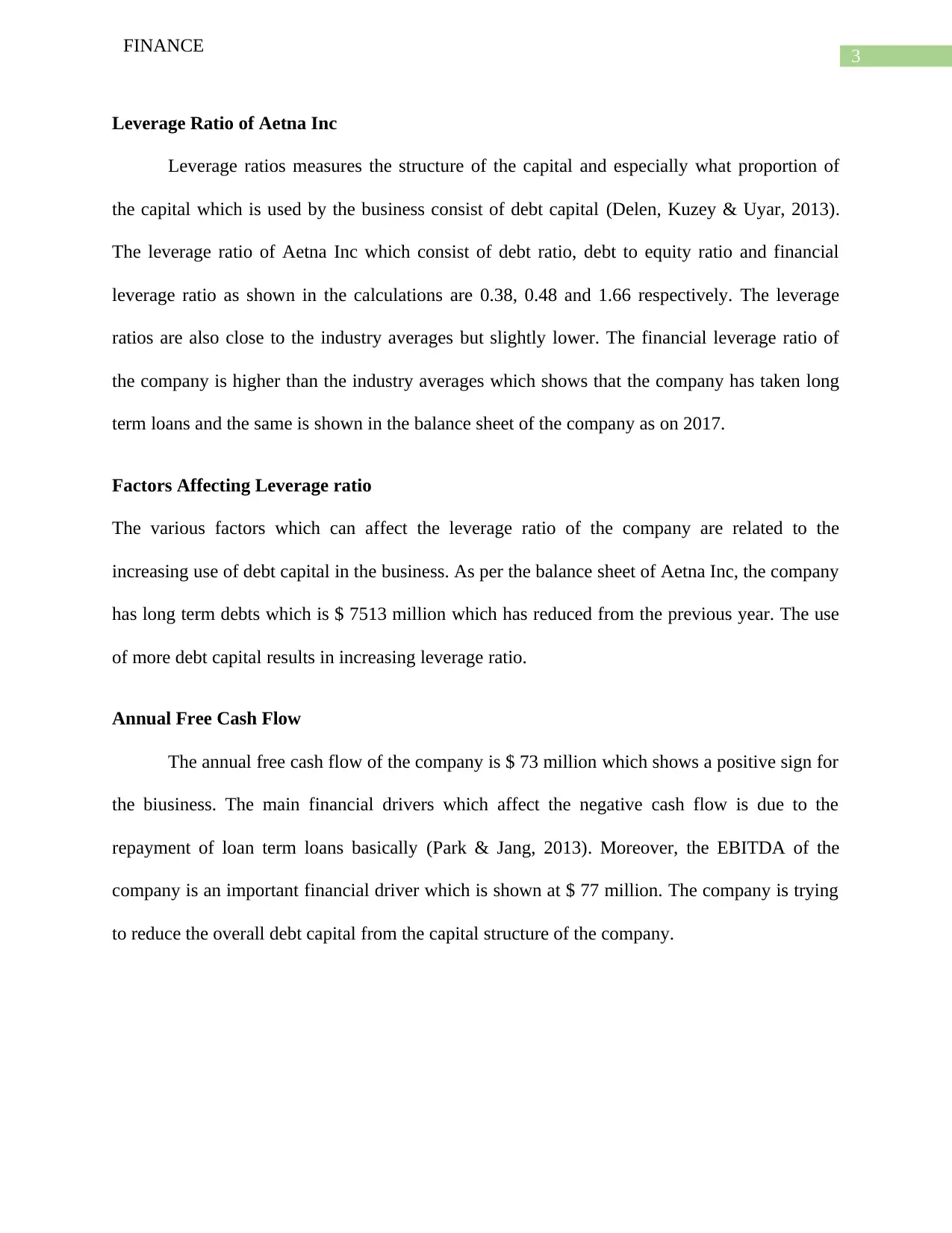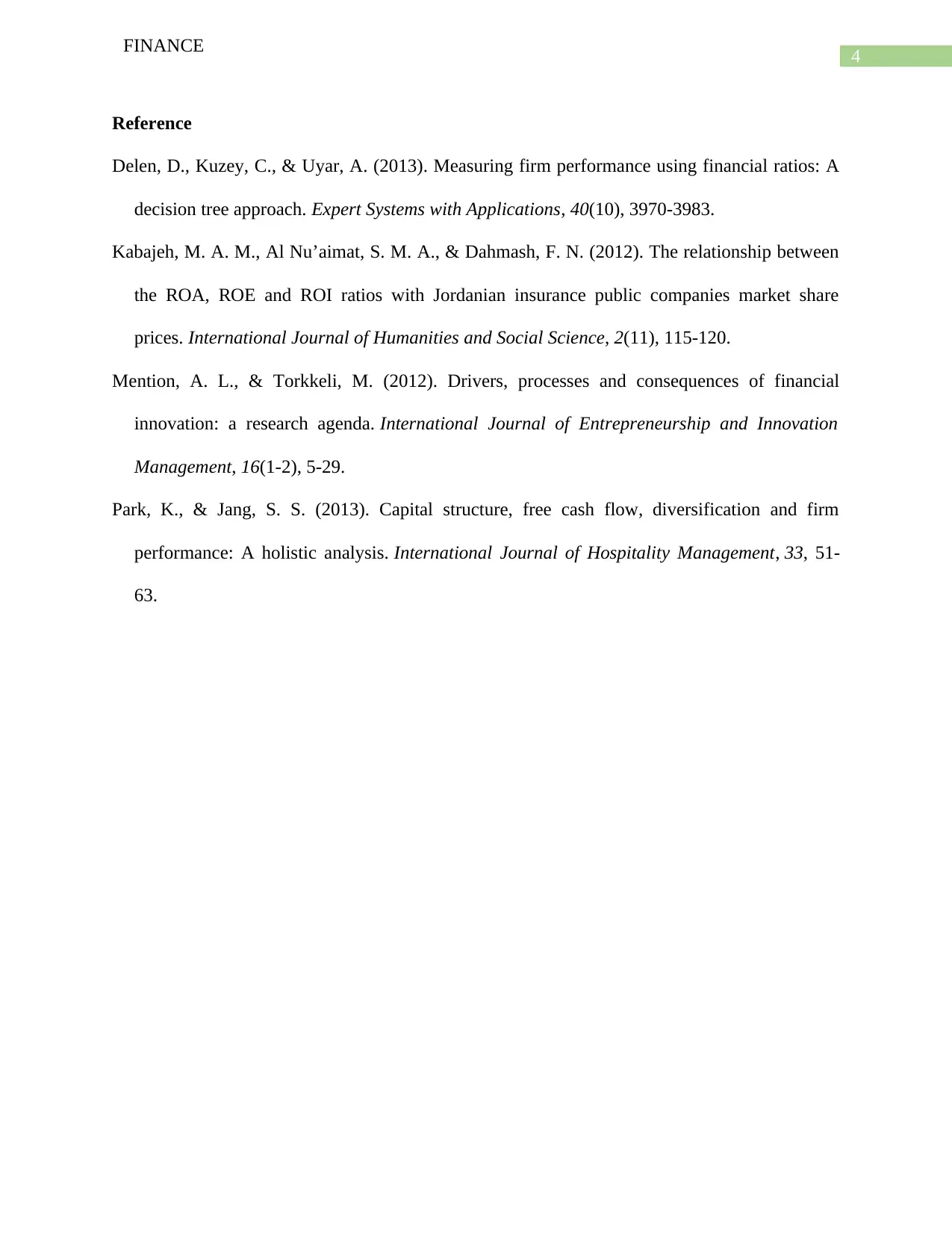Comprehensive Financial Analysis of Aetna Inc.: Key Ratios and Drivers
VerifiedAdded on 2021/04/24
|5
|879
|42
Report
AI Summary
This report provides a financial analysis of Aetna Inc., assessing its performance through various key financial ratios. The analysis covers profitability, including profit margins and return on equity, revealing that the company has been earning losses. It also examines the financial drivers, such as return on equity and total revenue, highlighting areas for improvement. The report further investigates Aetna Inc.'s liquidity, comparing its current and quick ratios to industry averages. Additionally, it analyzes the company's leverage ratios, including debt ratio and debt-to-equity ratio, and identifies factors affecting these ratios, such as the use of debt capital. The annual free cash flow and EBITDA are also discussed, along with the company's efforts to reduce debt. The report is supported by references to relevant financial literature.

Running head: FINANCE
Finance
Name of the Student:
Name of the University:
Author’s Note:
Finance
Name of the Student:
Name of the University:
Author’s Note:
Paraphrase This Document
Need a fresh take? Get an instant paraphrase of this document with our AI Paraphraser

1
FINANCE
Table of Contents
Profitability of Aetna Inc.................................................................................................................2
Financial Drivers of Aetna Inc........................................................................................................2
Liquidity of Aetna Inc.....................................................................................................................2
Leverage Ratio of Aetna Inc............................................................................................................3
Factors Affecting Leverage ratio.....................................................................................................3
Annual Free Cash Flow...................................................................................................................3
Reference.........................................................................................................................................4
FINANCE
Table of Contents
Profitability of Aetna Inc.................................................................................................................2
Financial Drivers of Aetna Inc........................................................................................................2
Liquidity of Aetna Inc.....................................................................................................................2
Leverage Ratio of Aetna Inc............................................................................................................3
Factors Affecting Leverage ratio.....................................................................................................3
Annual Free Cash Flow...................................................................................................................3
Reference.........................................................................................................................................4

2
FINANCE
Profitability of Aetna Inc
The profitability ratios of the company measure the overall profit generating capability of
the company. Such types of ratios include profit margin, Return on Equity (ROE), Return on
Assets and similar other ratios (Kabajeh, Al Nu’aimat & Dahmash, 2012). In this case, the
profitability ratio is measured for Aetna Inc which is engaged in the business of insurance
coverage. The profit margin of the company is in negative which shows that the company has
been earning losses and moreover is not performing that well considering the other businesses in
the industry. The return on equity and return on assets of the company is slightly lower than the
industry averages which are 12% and 7% respectively.
Financial Drivers of Aetna Inc
The financial drivers of the company for profitability are profit margin, high volume of
sales, the price which is charged for sales and similar other factors (Mention, & Torkkeli, 2012).
In the case of Aetna Inc, the profitability drivers for the company is the return on equity which
the company offers to the shareholders of the company. Moreover, the company has a negative
total revenue which is $318 million and the company needs to improve the same and have a
positive total revenue so that the net profit of the company can further increase.
Liquidity of Aetna Inc
Liquidity refers to how much cash and cash equivalents are present in the hand of the
company for the purpose of investment or any other activity. Liquidity of a company measures
the business’s ability to hold liquid cash for any requirement which may arise. In the case of
Aetna Inc the current ratio and quick ratio of the company are the same which is 1.1239 which is
quite close to the industry averages. This shows that the liquidity of the company is decent when
comparison is made with the other companies in the industry.
FINANCE
Profitability of Aetna Inc
The profitability ratios of the company measure the overall profit generating capability of
the company. Such types of ratios include profit margin, Return on Equity (ROE), Return on
Assets and similar other ratios (Kabajeh, Al Nu’aimat & Dahmash, 2012). In this case, the
profitability ratio is measured for Aetna Inc which is engaged in the business of insurance
coverage. The profit margin of the company is in negative which shows that the company has
been earning losses and moreover is not performing that well considering the other businesses in
the industry. The return on equity and return on assets of the company is slightly lower than the
industry averages which are 12% and 7% respectively.
Financial Drivers of Aetna Inc
The financial drivers of the company for profitability are profit margin, high volume of
sales, the price which is charged for sales and similar other factors (Mention, & Torkkeli, 2012).
In the case of Aetna Inc, the profitability drivers for the company is the return on equity which
the company offers to the shareholders of the company. Moreover, the company has a negative
total revenue which is $318 million and the company needs to improve the same and have a
positive total revenue so that the net profit of the company can further increase.
Liquidity of Aetna Inc
Liquidity refers to how much cash and cash equivalents are present in the hand of the
company for the purpose of investment or any other activity. Liquidity of a company measures
the business’s ability to hold liquid cash for any requirement which may arise. In the case of
Aetna Inc the current ratio and quick ratio of the company are the same which is 1.1239 which is
quite close to the industry averages. This shows that the liquidity of the company is decent when
comparison is made with the other companies in the industry.
⊘ This is a preview!⊘
Do you want full access?
Subscribe today to unlock all pages.

Trusted by 1+ million students worldwide

3
FINANCE
Leverage Ratio of Aetna Inc
Leverage ratios measures the structure of the capital and especially what proportion of
the capital which is used by the business consist of debt capital (Delen, Kuzey & Uyar, 2013).
The leverage ratio of Aetna Inc which consist of debt ratio, debt to equity ratio and financial
leverage ratio as shown in the calculations are 0.38, 0.48 and 1.66 respectively. The leverage
ratios are also close to the industry averages but slightly lower. The financial leverage ratio of
the company is higher than the industry averages which shows that the company has taken long
term loans and the same is shown in the balance sheet of the company as on 2017.
Factors Affecting Leverage ratio
The various factors which can affect the leverage ratio of the company are related to the
increasing use of debt capital in the business. As per the balance sheet of Aetna Inc, the company
has long term debts which is $ 7513 million which has reduced from the previous year. The use
of more debt capital results in increasing leverage ratio.
Annual Free Cash Flow
The annual free cash flow of the company is $ 73 million which shows a positive sign for
the biusiness. The main financial drivers which affect the negative cash flow is due to the
repayment of loan term loans basically (Park & Jang, 2013). Moreover, the EBITDA of the
company is an important financial driver which is shown at $ 77 million. The company is trying
to reduce the overall debt capital from the capital structure of the company.
FINANCE
Leverage Ratio of Aetna Inc
Leverage ratios measures the structure of the capital and especially what proportion of
the capital which is used by the business consist of debt capital (Delen, Kuzey & Uyar, 2013).
The leverage ratio of Aetna Inc which consist of debt ratio, debt to equity ratio and financial
leverage ratio as shown in the calculations are 0.38, 0.48 and 1.66 respectively. The leverage
ratios are also close to the industry averages but slightly lower. The financial leverage ratio of
the company is higher than the industry averages which shows that the company has taken long
term loans and the same is shown in the balance sheet of the company as on 2017.
Factors Affecting Leverage ratio
The various factors which can affect the leverage ratio of the company are related to the
increasing use of debt capital in the business. As per the balance sheet of Aetna Inc, the company
has long term debts which is $ 7513 million which has reduced from the previous year. The use
of more debt capital results in increasing leverage ratio.
Annual Free Cash Flow
The annual free cash flow of the company is $ 73 million which shows a positive sign for
the biusiness. The main financial drivers which affect the negative cash flow is due to the
repayment of loan term loans basically (Park & Jang, 2013). Moreover, the EBITDA of the
company is an important financial driver which is shown at $ 77 million. The company is trying
to reduce the overall debt capital from the capital structure of the company.
Paraphrase This Document
Need a fresh take? Get an instant paraphrase of this document with our AI Paraphraser

4
FINANCE
Reference
Delen, D., Kuzey, C., & Uyar, A. (2013). Measuring firm performance using financial ratios: A
decision tree approach. Expert Systems with Applications, 40(10), 3970-3983.
Kabajeh, M. A. M., Al Nu’aimat, S. M. A., & Dahmash, F. N. (2012). The relationship between
the ROA, ROE and ROI ratios with Jordanian insurance public companies market share
prices. International Journal of Humanities and Social Science, 2(11), 115-120.
Mention, A. L., & Torkkeli, M. (2012). Drivers, processes and consequences of financial
innovation: a research agenda. International Journal of Entrepreneurship and Innovation
Management, 16(1-2), 5-29.
Park, K., & Jang, S. S. (2013). Capital structure, free cash flow, diversification and firm
performance: A holistic analysis. International Journal of Hospitality Management, 33, 51-
63.
FINANCE
Reference
Delen, D., Kuzey, C., & Uyar, A. (2013). Measuring firm performance using financial ratios: A
decision tree approach. Expert Systems with Applications, 40(10), 3970-3983.
Kabajeh, M. A. M., Al Nu’aimat, S. M. A., & Dahmash, F. N. (2012). The relationship between
the ROA, ROE and ROI ratios with Jordanian insurance public companies market share
prices. International Journal of Humanities and Social Science, 2(11), 115-120.
Mention, A. L., & Torkkeli, M. (2012). Drivers, processes and consequences of financial
innovation: a research agenda. International Journal of Entrepreneurship and Innovation
Management, 16(1-2), 5-29.
Park, K., & Jang, S. S. (2013). Capital structure, free cash flow, diversification and firm
performance: A holistic analysis. International Journal of Hospitality Management, 33, 51-
63.
1 out of 5
Related Documents
Your All-in-One AI-Powered Toolkit for Academic Success.
+13062052269
info@desklib.com
Available 24*7 on WhatsApp / Email
![[object Object]](/_next/static/media/star-bottom.7253800d.svg)
Unlock your academic potential
Copyright © 2020–2025 A2Z Services. All Rights Reserved. Developed and managed by ZUCOL.





